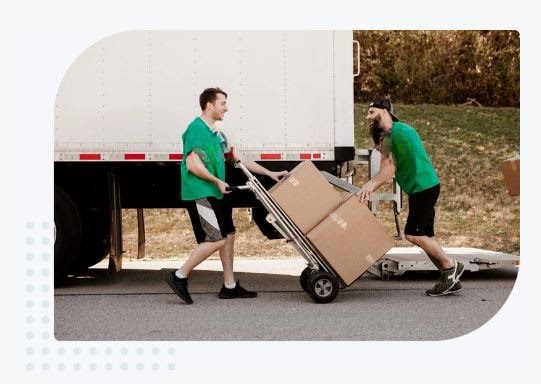
how to prepare for a move
The DNA Movers Move Prep Guide
Being prepared to move by the time your DNA Movers Pros arrive enables them to work as safely and efficiently as possible—and also saves you time and money. To this end, we’ve gathered the most helpful practices we’ve learned over the course of 300,000+ moves.
We’ve also compiled our best advice into a handy, printer-friendly guide. Click the link below to download a PDF with step-by-step instructions to manage your move seamlessly.
Get Organized and Make a Plan
60 Days Before your Moving Day Make a moving folder
The day you move can affect prices. We recommend moving on a weekday choosing a weekday and avoiding busy days like the first or last weekend of the month.
Schedule mover parking and freight elevator dates and times at both locations.
List all items with quantities and exact sizing. You can use a computer or phone but do it electronically so the data can be quickly sent to movers for bidding. Include model names and serial numbers in case items are lost or broken.
Check to see if Your furniture fits your new home. If any items don’t fit, add them to the “sell” or “donate” list.
If your long-distance move requires shipping your car, you may need to drop it off early. Before then, clean it out thoroughly. Don’t leave any valuables inside.
Request time off from work and inform the payroll department of your new address, so paychecks coincide with your moving date. Update your children’s schools and request school records. Include days off before and after your moving day.
Many apartment leases require a 30-day notice, but some are longer. Inform them now to avoid paying additional rent. During the call, make special arrangements to meet during your moveout day for a final walkthrough and provide keys.
Many apartment leases require a 30-day notice, but some are longer. Inform them now to avoid paying additional rent. During the call, make special arrangements to meet during your moveout day for a final walkthrough and provide keys.
If you will fly to your new home, buy tickets early for maximum savings. If it’s a multi-day journey, book hotels (AAA offers low rates) or Airbnbs and make other travel arrangements. Factor in pets.
If necessary, make an appointment at the DMV in your new state. Some destinations require new driver’s licenses within ten days of arriving, and you may need to schedule an appointment in advance.
Donate or sell items you don’t need
The less stuff you have, the quicker (and cheaper) your move will be. Think of your move as an opportunity to get rid of all the items you may have accumulated over the years. As a starting place, it’s a good idea to inventory your furniture to determine what will fit in your new home. Then consider having a garage or yard sale; selling your belongings on Craigslist, Facebook Marketplace, or eBay; and/or scheduling a donation pickup.


Get boxes and other moving supplies
It can be tough to estimate how many boxes you’ll need come move day! While this number is highly variable based on the amount of stuff you have, we’ve shared some general guidelines in this chart. It’s a good idea to buy wardrobe boxes to protect your clothing in transit (and makes unpacking clothes into a closet much easier). Make sure you have sturdy tape, permanent markers, and old newspapers or bubble wrap.
Pro Tip Save money by looking for free boxes at liquor stores, grocery stores, and restaurants.
Plan Ahead

Make a family “move day” plan
If you need time off work to move, be sure to put in the request ASAP. If you have kids, consider hiring a babysitter or making other childcare arrangements for move day.

Reserve freight elevator
If you live in an apartment building with a service or freight elevator, be sure to reserve it well in advance. This simple task will save a LOT of time on move day!

Acquire parking permits
Think through the best (i.e. closest) place for a moving truck to park outside your residence. If you live in a city, you may need a special permit to reserve truck parking on the street.
30 Days Before your Moving
Set up disconnect and reconnect dates for cable, internet, gas, water, electricity, and house phone lines. Additionally, update the insurance agent attached to your home insurance, health insurance, and auto insurance policy, etc., as well as all service providers, such as your home security, pest-control, house-cleaning, your cell phone company, and lawn-care companies. Be sure to also change your address and voter registration through the USPS website’s address form.
Update your address on all subscriptions and online accounts. Make address changes for any items that will arrive after your move and update all credit cards, so bills and payments correspond to the new address upon arrival.
If you change banks, some fund transfers and new checks can take a few weeks, so plan early.
While you pack, do touchups to get your entire security deposit back. Ask your property manager if there are other moving day requirements.
Begin a conversation with your kids about moving and the feelings they might experience. Give them time to say goodbye to their friends at their current school, as well as return any library books.
Consider scheduling a sitter to make your moving day easier for you, your kids, and your pet kids.
Return any borrowed items, retrieve any you loaned, and ask for any moving help now, so they have plenty of notice.
In between work, please read our blog and city guides for resources that help you get settled. Make a list of emergency numbers for your new neighborhood.
If driving your car a long distance, take it in for service – tires, oil, the works.
Pack Like a Pro

Start with the spaces and things you use the least
When beginning the packing process, start with the “furthest corners” of your home, such as your basement, attic, and garage. Pack items you won’t use immediately: off-season clothes and outerwear, books, holiday decorations, and other non-essential items. Make sure all boxes are sealed with packing tape and clearly marked with their destination (and the term “fragile” when appropriate).
Pro Tip When packing up your infrequently used items, take a photo of the contents of each box along with its label. Because you don't need/use these items as much, you are more likely to unpack them last (and therefore forget what is in each box).
One Week Before Your Move
Do a deep clean to avoid cleaning service fees, and pay attention to areas you tend to overlook, like windows and floorboards. Bathrooms, kitchens, and major appliances you don’t own should get a thorough scrub down and clear slow drains. Magic erasers work great on scuff marks.
Think of fun games or activities that will keep your kids occupied during the unpacking process, or give each child personal tasks with rewards. Bonus points if you can get them to help move!
When packing, aside clothing and toiletries to fill in a suitcase and have a few plates and utensils on hand for any final meals.
Donate any food you won’t be able to use.
Give friends and neighbours a chance to say goodbye. They may even have advice for living in your new location.
Pack fragile items
It’s a good idea to take stock of any items that will require special attention, such as delicate glassware or artwork, and pack them in advance. Use smaller, sturdy boxes when packing fragile items; you can pad the contents with bubble wrap, crumpled newspaper/packing paper, styrofoam peanuts, or even towels and blankets. Make sure that these boxes are labeled and clearly marked “fragile.”.
Make sure to empty the drawers of your dresser(s) and any other furniture that houses clothing. Use wardrobe boxes to pack anything that is already hanging in your closet (these also make unpacking a snap). Set aside a suitcase or two with clothes and toiletries that you’ll want to have handy during the first few days at your new home.
Remove any art, framed photos, and mounted pieces (e.g. shelving) from walls, and make sure to store mounting hardware in a safe place.
It’s difficult and expensive to transport perishable foods, so start eating your way through your fridge and freezer. Alternatively, you can make a plan to donate your perishable food a couple days ahead of your move.

Pro Tip Store any screws or hardware in a plastic bag that is clearly labeled with the item it corresponds to. Don’t tape the bag to the item (it can get knocked off in transit); instead, keep all of your labeled hardware bags in a central place for easy access.
2-4 Days Before Your Service

Dispose of hazardous liquids and materials
or make a plan to transport them yourself. Please note that DNA MoversPros cannot move certain hazardous items, including but not limited to: paint, compressed gasses (aerosols), or anything flammable (ammonia, bleach, gasoline, motor oil, etc). Many common household cleaning products fall within this definition. Additionally, take care to remove gasoline and/or batteries from your lawnmower, yard tools, and/or gas grill before move day. Please review our Terms of Service below for a full list of items we cannot move.
Remember to check our terms of service for items we don't pack or move.
Pack up small electronics and appliances
Pack computers, electronics, and other small household appliances into their original boxes (if you still have them). Otherwise, make sure to use small, sturdy boxes with plenty of bubble wrap or packing peanuts to ensure safe transit. Note: If electronics are not in boxes on the day of your move, DNA Movers Pros will either decline to move them or ask that you sign a waiver of liability.


Disassemble furniture to save time & money
While DNA Movers Pros can disassemble and reassemble furniture, you may choose to expedite the duration of your move (and therefore save money) by taking apart furniture yourself. Plan time to break down furniture that will be too large to fit through doorways, down staircases, or inside elevators. Keep all hardware and screws in clearly labeled plastic bags. Bellhop Pros cannot disassemble workout equipment, so plan to do this task yourself or make other arrangements for your heavy gym equipment.
Disconnect and drain all appliances
While DNA Movers Pros can move large appliances for you, they can only do so if these items are empty, disconnected, and completely dry ahead of time. Refrigerator and freezer: Empty of all contents, then disconnect them from their power source. Keep the doors open overnight, with a towel underneath to contain any dripping. Then do a final wipedown in the morning to make sure everything is dry and ready for transport. Washer and dryer: Disconnect them from their power source. Locate the water valves and turn them off before unhooking the cold and hot water hoses from the wall. Make sure to empty the hoses of any leftover water.


Dismount and pack your TV in its original box
Please keep in mind that DNA Movers Pros cannot be responsible for dismounting your TV. In addition, any televisions must be packed securely in either their original box or an appropriately sized electronics box. The latter can be purchased from a home improvement store, such as The Home Depot. Note: If electronics are not in boxes on the day of your move, DNA Movers Pros will either decline to move them or ask that you sign a waiver of liability.
Pro Tip Take pictures of your TV’s electronic connections. Having a photo of how the wires are arranged will save you from a headache when it’s time to put everything back together later.
24 Hours Before Your Service
Please make sure there is an unobstructed path (both outside and inside) for your movers to navigate. Anything a mover could stumble on – toys, branches, shoes, small furniture – must be dealt with ahead of time to ensure the safety of your movers and the items they’re hauling.
If you have a vehicle, please park it where it won’t be an obstacle for movers going back and forth.
To ensure your mattresses and box springs are protected from dust, dirt, and water on move day, it’s a good idea to procure mattress bags. You can buy them at your local home improvement store (they typically cost ~$10 a piece), and they’re well worth the investment.
Your Pros will move your items with care, but we cannot replace items of sentimental value (such as antiques, artwork, photo albums, and jewelry) if something were to happen. Pack your personal vehicle with anything you don’t want transferred in your moving truck.
Like you would before you leave a hotel, check all hidden areas like attics, basements, and closet corners. Don’t leave any critical items behind! Commonly overlooked items include mounted light fixtures, things that plug into a wall (e.g. charging cables), wall-mounted mirrors, and wall and door hooks.
Day-of Details

Prep for your packers' arrival
In addition to clearing a path for your DNA Movers Pros to move through your home, consider putting down paper, cardboard, and/or drop cloths to protect wood floors and carpets.
Don't forget your pets!
Move day can be stressful or even dangerous for your pets. Consider dropping them off at daycare for the day, or leaving them with a friend. At the very least, we recommend keeping your pets in a quiet room with the door closed (in this case, make sure to inform your Bellhop Pros so they don’t inadvertently let your pets out).


Discuss the plan
When your movers arrive, they’ll do a walkthrough of your home to devise a loading plan. This is a good time to point out any fragile items that require special care, or furniture pieces that need to be disassembled. If there are any items that you do not want your movers to pack onto the truck, be sure to flag them at this time.
After Your Move
Make sure that nothing needs attention, and all maintenance that was agreed upon was completed. If there are issues, take pictures while the rooms are empty to avoid questions of if issues were due to the moving process.
Unpack perishables and fragile items to spot breakage. If anything’s broken, get in touch.
Hopefully, the previous owners did a deep cleaning before moving out, but it doesn’t hurt to give kitchen and bathroom surfaces a once-over.
Time to restock and go grocery shopping. Start with the essentials and pick up easy-to-prepare meals or order in for the first day or two so you have more time to unpack.
Organize keys and set up your security system for additional security.
Make copies or house and mailbox keys, and include copies for a friend, neighbor, or someone else you trust.
